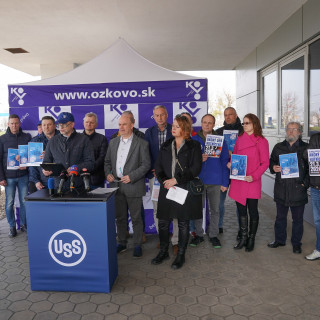
The product has been well-tried in everyday use Back in October of 2014 the specialists of our subsidiary, RMS, a. s. Košice, tested a new type of concrete with an admixture of gravel from our blast furnace slag. They applied this material to a 50-meter stretch of heavily-damaged road S11-2 to find out whether it could withstand ordinary operating loads and also our year-round weather conditions. The concrete was found to be very durable, and remains so also at present; it does not show any damage after the period of more than a year in spite of the fact that dozens of heavy-duty 40-ton vehicles drive on its surface day after day.
Conclusions from the test sound positive. Our colleagues from RMS can now state that the mixture of concrete with blast-furnace slag of the CB3 brand is applicable for renewal of our roads and pavements, but also for other concrete work within U. S. Steel Košice. The artificial metallurgical aggregates made from blast furnace slag are a convenient alternative to natural gravel. "After last year´s positive test results, we have developed a project for the same formula of concrete production that we applied to that road within the Carnegie Way transformation process," says Jozef Verespej, Director of the Repairs and Services Division at the RMS subsidiary. “If anyone at the steelworks comes up with a request for concreting floors, access roads or paths, we can now use this type of material.” Staff at RMS are currently implementing a new contract. They are preparing a floor surface for the Shipping operation at the Hot Rolling Mill intended for storing flat products. Rastislav Holub of the Energy Management operation leads a team of specialists managed by Jozef Pavlovic. The request for the concrete floor amounted to a net surface of 1300 square meters. Work started on December 1 of last year. "On the original spot," J. Pavlovic explains, "there was an old line, which they first dismantled, but a large hole remained in the ground after its removal. Our first task was to adjust the surface, of course, using gravel from our blast furnace slag." Once the surface was rolled out, they poured on the CB3 concrete containing the blast-furnace slag, using eighty cubic meters of this material. Once the surface was made even, a ten-centimeter thick concrete floor was laid on the top. They used another 174 cubic meters of "self-made" concrete for this surfacing. "We poured the concrete containing the blast-furnace slag in the form of a chess-board, with each block done individually. When the frosts hit our region, we had to interrupt the work for several days. Such technology does not allow concreting if the ambient temperature drops below five degrees Celsius," explains Rastislav Holub, and notes that after this work is completed they will apply a special chemical spreading material on the top surface, which increases the strength of the floor itself as well as providing a dust-free effect. They will start using this technology at the Hot Rolling Mill in the coming days.
The staff of RMS believe that this concrete containing the blast-furnace slag will find its application also the case of other contracts.












